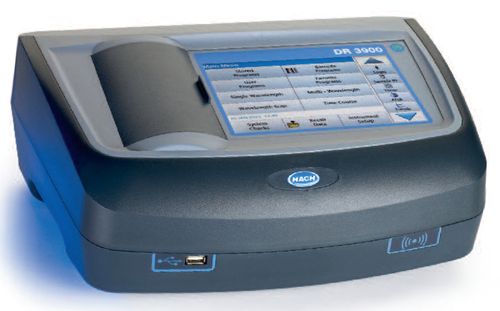Hach Lange, a German manufacturer of devices for analyzing water, has released a version of its new spectrophotometer that uses RFID to acquire data related to chemicals the company provides for water testing, and enable the instrument to automatically update its configuration for those chemicals. To test the quality of their water, water-treatment facilities, municipalities and utility companies put water samples into vials partially filled with chemical reagents that can interact with compounds such as carbon or chlorine. They then use Hach Lange spectrophotometers to measures the wavelengths of light that passes through water samples to identify the concentration of the chemical substances present.
With an HF 13.56 MHz RFID passive tag affixed to the box containing vials of a chemical reagent used to detect the concentration of a specific chemical that may be in the water, the RFID-enabled version of Hach Lange’s new DR 3900 spectrophotometer can appropriately update the calibration for the test at hand, as well as store data such as the expiration data for that reagent. The system also can include an RFID-enabled key fob that users can employ to enable water sample testing by placing the key fob within read range of the spectrophotometer’s RFID reader, explains Andreas Schroers, global product manager of Hach Lange’s spectrophotometer-lab systems business unit.
The DR 3900 was commercially released to the European market in March, and the North American market in May, and Hach Lange customers on both continents are already using the RFID functionality in their laboratories, says Schroers. The new spectrophotometer offers greater safety of testing by ensuring the instrument’s calibration is done automatically, according to the needs of the reagent, thereby guaranteeing the test was done properly. The RFID system also provides an electronic record of the ISO certification (used by certified testing laboratories to indicate a chemical meets standards required for testing) of the chemical for labs to store and provide, if necessary, for certification.
When a user mixes a water sample with the chemical in the glass vial, provided by Hach Lange, he or she then waits to allow the mixture to incubate, then places the vial in a spectrophotometer to analyze the substance. With or without RFID, Hach Lange spectrophotometers use an internal bar-code scanner to read the ID number printed on the vial to determine what kind of test is being done, based on the chemical in the vial, and then adjusts its own settings to begin testing. However, the non-RFID spectrophotometer requires some human intervention. For example, testing often requires an update to calibration in the device based on the materials used to create the reagents. This re-calibration must be done in some cases every few months, in other cases, less often. To undertake that re-calibration, however, staff must typically download software and then upload that software into the spectrophotometer. If this process gets missed, the reliability of the test is in question.

With RFID the process is done automatically. Each box, containing 25 vials of testing chemicals, now comes equipped with an HF 13.56 MHz RFID tag, complying with ISO 15693, attached to the box’s interior. When a test is being conducted, users place the box within five centimeters of a MetraTec reader built into the front right-hand section of the DR 3900 (the read range is set low to prevent inadvertently reading any tags attached to other nearby containers of reagents).
Each TagStar Systems tag, made with an STMicroelectronics RFID chip with 2048 bits of memory, stores data that includes the reagent’s serial and lot number, the expiration date, calibration data and ISO standard information. When the DR 3900’s RFID interrogator reads this calibration data, the spectrophotometer’s firmware is instructed to recalibrate the device, based on that data.
In that way, says Schroers, the system provides the laboratory with assurance that the test was carried out appropriately and therefore the results can be trusted as being accurate.
Hach Lange continues to market its spectrophotometers both with and without RFID technology, however all vial containers will come equipped with RFID tags, says Schroers, at no increase in price.
Each lab technician can be assigned an RFID key fob (manufactured by AEG ID), and the spectrophotometer’s reader can be set to operate only after the unique ID number of that key fob is read, thereby preventing any unauthorized use of the spectrophotometer.
In August, Hach Lange will also provide a sample-tracking system in which users can use RFID to record data about the location, time and date a water sample was obtained and by whom. In this case, Hach Lange will provide 13.56 MHz AEG ID tags that can be attached to a stationary object to identify the location from which water samples are poured, as well as a tag for the container itself. Hach Lange will also provide a similar tag for each staff member to carry or wear. When the tagged container is filled with water, the employee will use the handheld device to read the ID and name encoded to his own tag, then the location tag, and input data such as date and time the sample is being collected. All that data is then written to the tag on the container.
When the container is taken to the laboratory for testing, it can be placed within read range of the spectrophotometer and the tag data will be read and stored with the test results. In this way, a system that was previously managed with pen and paper can be completed electronically, with data stored in the spectrophotometer itself.

